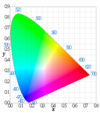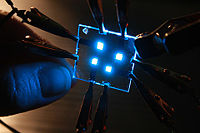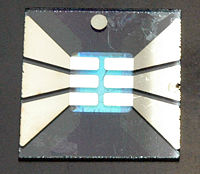Difference between revisions of "Main Page"
Jump to navigation
Jump to search
Cmditradmin (talk | contribs) |
|||
| Line 34: | Line 34: | ||
*Characterization of Electro-optic Materials (Norwood) | *Characterization of Electro-optic Materials (Norwood) | ||
*[http://thzpolymers.pbwiki.com/ THz Polymers Wiki (Hayden)] | *[http://thzpolymers.pbwiki.com/ THz Polymers Wiki (Hayden)] | ||
===Third-order Processes, Materials & Characterization === | ===Third-order Processes, Materials & Characterization === | ||
| Line 66: | Line 67: | ||
===Center Overview - === | ===Center Overview - === | ||
*Photonic Integration (Dalton) | |||
| Line 76: | Line 77: | ||
*Dispersion and Scattering of Light | *Dispersion and Scattering of Light | ||
*Diffraction of Light | *Diffraction of Light | ||
===Luminescence and Color=== | ===Luminescence and Color=== | ||
| Line 85: | Line 87: | ||
*[[Chromaticity]] | *[[Chromaticity]] | ||
*[[Additive and Substractive Color Mixing]] | *[[Additive and Substractive Color Mixing]] | ||
===Molecular Orbitals – (Marder & JLB)=== | ===Molecular Orbitals – (Marder & JLB)=== | ||
*Atomic Orbitals and Nodes | *Atomic Orbitals and Nodes | ||
*Electronegativity and Bonding between Atoms | *Electronegativity and Bonding between Atoms | ||
*Sigma and | *Sigma and Pi Orbitals | ||
*Electronic Coupling between Orbitals | *Electronic Coupling between Orbitals | ||
*Donors and | *Donors and Acceptors | ||
| Line 131: | Line 134: | ||
*Double Refraction and Birefringence | *Double Refraction and Birefringence | ||
*History of Liquid Crystals | *History of Liquid Crystals | ||
*Director – Degrees of | *Director – Degrees of Order in Liquid Crystals | ||
*Classification and Examples of Liquid Crystals, Part 1 | *Classification and Examples of Liquid Crystals, Part 1 | ||
*Classification and Examples of Liquid Crystals, Part 2 | *Classification and Examples of Liquid Crystals, Part 2 | ||
| Line 165: | Line 168: | ||
===Organic Photonics Applications in Information Technology === | ===Organic Photonics Applications in Information Technology === | ||
*Modulators for | *Modulators for Fiber Communication | ||
| Line 173: | Line 176: | ||
*[[Conducting Tip Atomic Force Microscopy]] | *[[Conducting Tip Atomic Force Microscopy]] | ||
*[[Organic Photovoltaic Fabrication and Test Apparatus]] | *[[Organic Photovoltaic Fabrication and Test Apparatus]] | ||
*[[Two- | *[[Two-Photon Spectroscopy]] | ||
== Research Methods == | == Research Methods == | ||
*[[Lab Notebook]] | *[[How to Keep a Lab Notebook]] | ||
*[[ | *[[How to Give a Research Presentation]] | ||
*[[Scientific Paper]] | *[[Writing a Scientific Paper]] | ||
*[[ | *[[Writing a Successful Proposal]] | ||
*[[Mentoring]] | *[[Mentoring]] | ||
==[[Photonics Education Links | ==[[External Photonics Education Links]]== | ||
==[[Acronyms and Unit Abbreviations]]== | ==[[Acronyms and Unit Abbreviations]]== | ||
Revision as of 11:58, 6 May 2009
Center for Materials and Devices for Information Technology Research
This wiki is a reference collection on photonics. Most of the text has been captured from a series of lectures recorded in 2005-2008 by Center faculty Jean-Luc Bredas (Georgia Tech), Neal Armstrong (University of Arizona) and Seth Marder (Georgia Tech). You may also want to search the
CMDITR Photonics Digital Libary for individual learning objects.
(check out the OLED section below- the first we are building out)
GRADUATE COURSE MODULES OUTLINE
Thrust 1 Organic Electro-Optic and All-Optical Materials and Devices
Propagation of Light (Bredas)
- Light Propagation in Materials
- Optical Fibers
- Total Internal Reflection
- Planar Dielectric Waveguides
- Optical Fiber Waveguides
- Dispersion and Attenuation Phenomena
- Optical Fiber Materials
- Optical Communication Systems
- Materials (Carl Bonner)
Quantum Mechanical and Perturbation Theory of Polarizability (Bredas, Robinson, Rehr)
Second-order Processes, Materials & Characterization
- Second-order Processes (Marder)
- Structure-Property Relationships for Second-order Nonlinear Optics
- Second-order NLO Materials (Marder)
- Second-order Material Design (Jen)
- Characterization of Molecular Properties of Second-order Materials (Reid)
- Characterization of Electro-optic Materials (Norwood)
- THz Polymers Wiki (Hayden)
Third-order Processes, Materials & Characterization
- Introduction to Third-order Processes and Materials (Marder)
- Two Photon Absorption (Marder)
- Advanced Concepts in Third-order Processes
- Characterization of Third-order Materials (Perry)
Synthesis of Organic Semiconductors (Luscombe, Reid)
Techniques for Fundamental Processes (Ginger)
Design of n-type Semiconductors for Organic Electronic Applications
Lasers (Bredas)
Integrated Si Photonics (Hochberg)
Thrust 2 Light Sources and Organic Electronics
Center Overview -
- Photonic Integration (Dalton)
Basics of light– (JLB)
- Propagation of Light
- Reflection and Refraction
- Total Internal Reflection
- Dispersion and Scattering of Light
- Diffraction of Light
Luminescence and Color
- Luminescence Phenomena
- Electromagnetic Radiation
- Electromagnetic Spectrum
- Color
- Chromaticity
- Additive and Substractive Color Mixing
Molecular Orbitals – (Marder & JLB)
- Atomic Orbitals and Nodes
- Electronegativity and Bonding between Atoms
- Sigma and Pi Orbitals
- Electronic Coupling between Orbitals
- Donors and Acceptors
Electronic Band Structure of Organic Materials – (JLB)
- Introduction
- Electronic Structure of Hydrogen
- The Polyene Series, Part 1
- The Polyene Series, Part 2
- Bloch's Theorem, Part 1
- Bloch's Theorem, Part 2
- Electrical Properties
- Electronic States versus Molecular Levels
Absorption and Emission of Light – (JLB & Marder)
- Introduction
- Changes in Absorption Spectra
- Jablonski diagram
- Absorption, Internal Conversion, Fluorescence, Intersystem Crossing, and Phosphorescence Processes
- Spectroscopy, Extinction Coefficient, Oscillator Strength, Transition Dipole Moment
- Absorption and Emission
- Photochromism
- Interchain Interactions
Transport Properties– (JLB)
- Introduction
- Band Regime versus Hopping Regime
- Electronic Coupling
- Model Calculations of Electronic Coupling, Part 1
- Model Calculations of Electronic Coupling, Part 2
- Small Electronic Couplings and Marcus Theory
- Intramolecular Reorganization Energy
- Electron-Phonon Coupling
Liquid Crystals and Displays – (Marder)
- Introduction to Liquid Crystals
- Double Refraction and Birefringence
- History of Liquid Crystals
- Director – Degrees of Order in Liquid Crystals
- Classification and Examples of Liquid Crystals, Part 1
- Classification and Examples of Liquid Crystals, Part 2
- Alignment
- Freederickz Transition and Dielectric Anisotropy
- Liquid Crystal Displays
Organic Light Emitting Diodes - OLED
- OLED Device Applications
- Light Emitting Electrochemical Processes
- The OLED test cell
- What is a Light Emitting Diode?
- The first OLEDs
- Organic/Organic Heterojunctions in OLEDs
- OLED Charge Mobilities
- Organic Heterojunctions
- Fluorescent/Phosphorescent Dopants
- Metal Complex Dopants
Organic Solar Cells
- Definition
- Energy Needs
- Solar Technologies
- Major Processes in Organic Solar Cells
- Materials used in Organic Solar Cells
- Organic Heterojunctions in Solar Cells
- Physics of Solar Cells
- Energy vs Charge Transfer at Heterojunctions
- Current OPV Research Directions
Organic Photonics Applications in Information Technology
- Modulators for Fiber Communication
Recent results of “state-of-the-art” STC research
Research Equipment and Devices
- Photoelectron Spectrometer XPS and UPS
- Conducting Tip Atomic Force Microscopy
- Organic Photovoltaic Fabrication and Test Apparatus
- Two-Photon Spectroscopy
Research Methods
- How to Keep a Lab Notebook
- How to Give a Research Presentation
- Writing a Scientific Paper
- Writing a Successful Proposal
- Mentoring


